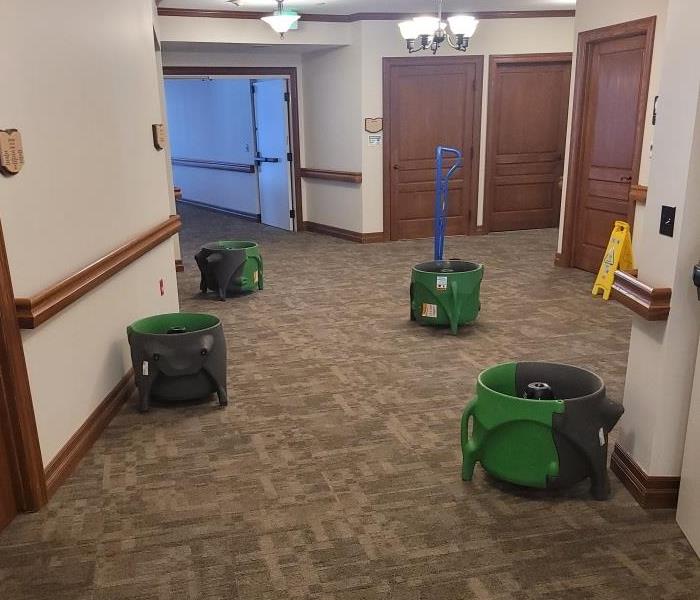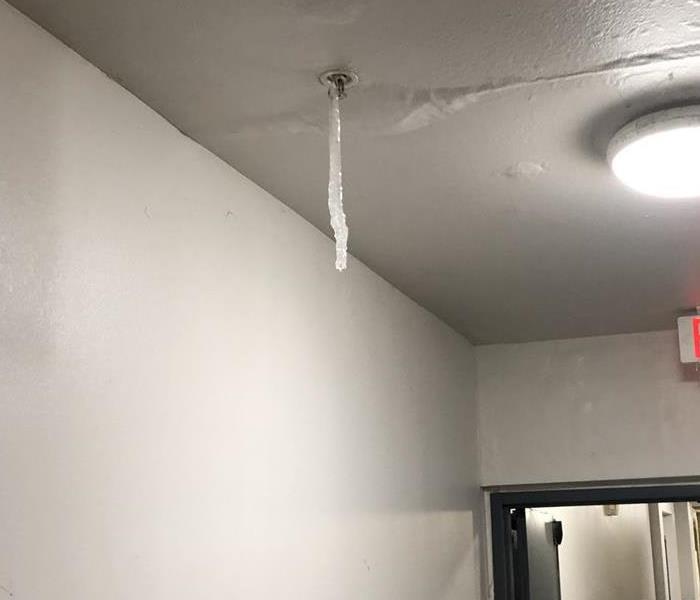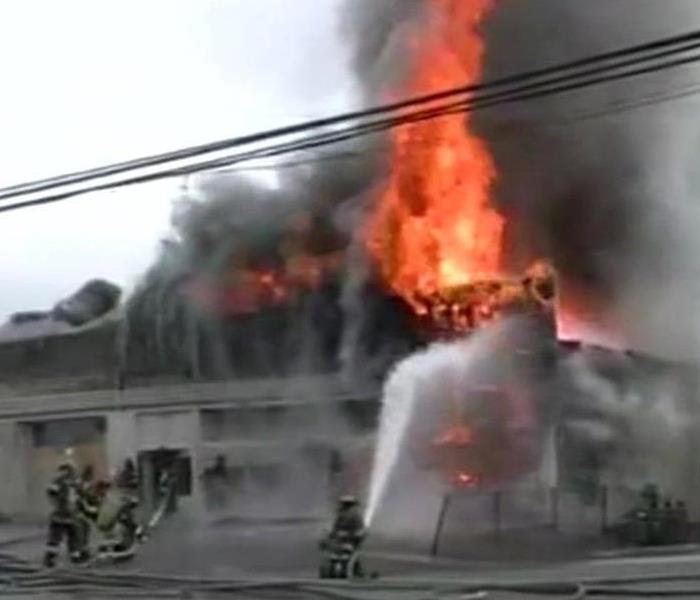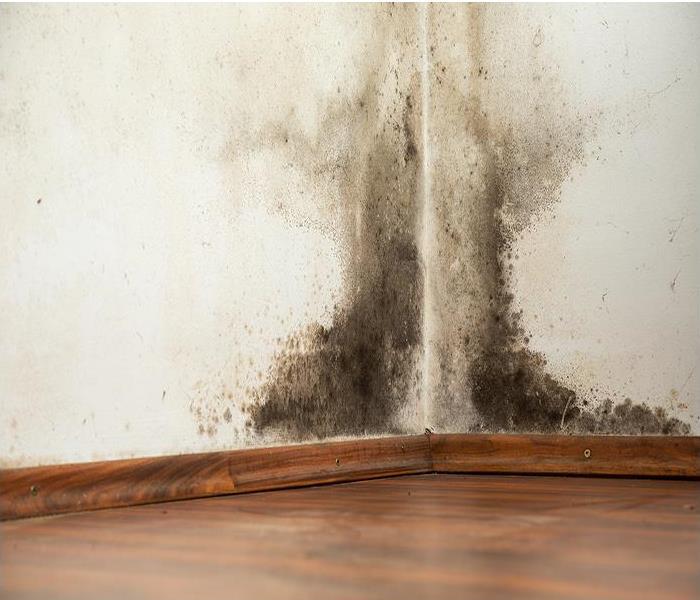Recent Commercial Posts
Is Your Business Prepared For Freezing Weather
1/31/2022 (Permalink)
 A burst pipe caused this business to flood, Drying Equipment set to help start the drying process
A burst pipe caused this business to flood, Drying Equipment set to help start the drying process
Over time Plumbing can become weak and wore down. Sometimes the insulation around the pipes may not be as efficient as it once was. If this should happen and plumbing happens to be on an exterior wall, it can lead to a frozen pipe and once the temperature rises, it can burst, causing water to go everywhere. It does not take a big crack in a pipe to allow gallons and gallons of water to come out. Damage that can happen from this can be as small as some flooring that needs to come to multiple floors of flooring, walls, insulation and ceilings that need to come out and be repaired.
If this loss should happen to you, call SERVPRO of Mt Pleasant, Clare and Houghton Lake. We have the experience and know how to get you dried out and get your doors back open quicker. We understand that the longer it takes to get the water dried out, the longer it can take to get back to business.
Apartment Complex
6/1/2021 (Permalink)
 Ice forming from a broken sprinkler line
Ice forming from a broken sprinkler line
Winter Storm Uri hit several areas in the south in 2021 causing an unprecedented amount of damage to residents and businesses throughout the area. SERVPRO of Mt.Pleasant, Clare and Houghton Lake was able to pack up and head south while most of the region was covered in snow and ice and still facing record low temps. A 250 unit apartment complex was one of many buildings that experiences frozen and busted pipes after it had experienced power outages. We assisted in the tear out and helped out many of the residents get the water damaged materials out and on their way to being back into their residences. The residents of Texas were very appreciative that we would come all the from Michigan to help and we were glad that we able to help with the situation that they were in.
Four Causes of Commercial Fires
4/23/2018 (Permalink)
 Commercial fire and fire department working on putting it out.
Commercial fire and fire department working on putting it out.
In 2017, a whopping 100,500 Commercial Fires were reported. A large number of these fires resulted in injuries, loss of life, and huge monetary losses. Although it is commonly thought that commercial fires are caused by human error, this is not always the case. There are four major reasons that commercial or non-residential buildings go up in flames.
- Electrical Fires – Electrical systems or appliances are all too common causes of commercial fires. Businesses sometimes hire individuals that are not qualified to modify their circuits or electrical outlets. This can lead to a number of problems and code violations, putting people and property in serious danger. The electrical equipment itself has also been known to cause fires when they are overloaded or misused and lacking proper maintenance.
- Arson – As unlikely as it may seem, arson is actually one of the leading causes of workplace injuries, fire damage, and even death in commercial buildings. As it is a fire that is intentionally set to cause damage, arson may lead to a catastrophic loss of life and property. This horrible crime may be an act of vandalism, an act of revenge by unhappy clients or workers, or even instigated by the owner of the property for insurance purposes. It is important to have these situations thoroughly investigated by the proper authorities.
- Boilers, Water Heaters, and Furnaces – While we do not have to worry about furnaces and boilers here in Florida, these three appliances are not always installed according to codes for their installation, maintenance, and use. Improper installation or a lack or maintenance could trigger a fire in your building. Additionally, storing flammable or combustible materials near them could also result in a fire.
- Human Error – While arson is a big problem, not every fire set by humans is malicious – a lot of the time it is an innocent accident. A smoldering cigarette, forgotten coffee pot, or knocking liquids on electrical equipment could all result in an office fire. Those who are negligent in office safety protocol could also start a fire with acts such as stacking or covering electrical equipment or improperly storing flammable items.
Mold Remediation in Schools and Commercial Buildings
4/23/2018 (Permalink)
As the public becomes more aware about the effects of mold exposure, concern about indoor mold has steadily increased. Here are some guidelines for the remediation/cleanup of mold and moisture problems in schools and other commercial buildings. These guidelines serve as a tool to protect the health of building occupants and remediators, and have been designed for:
- Building managers
- Custodians
- Others who are responsible for commercial building and school maintenance
It should serve as a reference for potential mold and moisture remediators. Using this document, individuals with little or no experience with mold remediation should be able to make a reasonable judgment as to whether the situation can be handled in-house. It will help those in charge of maintenance to evaluate an in-house remediation plan or a remediation plan submitted by an outside contractor1. Contractors and other professionals who respond to mold and moisture situations in commercial buildings and schools may also want to refer to these guidelines.
Molds can be found almost anywhere; they can grow on virtually any organic substance, as long as moisture and oxygen are present. There are molds that can grow on wood, paper, carpet, foods, and insulation. When excessive moisture accumulates in buildings or on building materials, mold growth will often occur, particularly if the moisture problem remains undiscovered or unaddressed. It is impossible to eliminate all mold and mold spores in the indoor environment. However, mold growth can be controlled indoors by controlling moisture indoors.
Molds reproduce by making spores that usually cannot be seen without magnification. Mold spores waft through the indoor and outdoor air continually. When mold spores land on a damp spot indoors, they may begin growing and digesting whatever they are growing on in order to survive. Molds gradually destroy the things they grow on.
Many types of molds exist. All molds have the potential to cause health effects. Molds can produce allergens that can trigger allergic reactions or even asthma attacks in people allergic to mold. Others are known to produce potent toxins and/or irritants. Potential health concerns are an important reason to prevent mold growth and to remediate/clean up any existing indoor mold growth.
Since mold requires water to grow, it is important to prevent moisture problems in buildings. Moisture problems can have many causes, including uncontrolled humidity. Some moisture problems in buildings have been linked to changes in building construction practices during the 1970s, 80s and 90s. Some of these changes have resulted in buildings that are tightly sealed, but may lack adequate ventilation, potentially leading to moisture buildup. Building materials, such as drywall, may not allow moisture to escape easily. Moisture problems may include:
- Roof leaks
- Landscaping or gutters that direct water into or under the building
- Unvented combustion appliances
- Delayed maintenance or insufficient maintenance are also associated with moisture problems in schools and large buildings
Moisture problems in portable classrooms and other temporary structures have frequently been associated with mold problems.
When mold growth occurs in buildings, adverse health problems may be reported by some building occupants, particularly those with allergies or respiratory problems. Remediators should avoid exposing themselves and others to mold-laden dusts as they conduct their cleanup activities. Caution should be used to prevent mold and mold spores from being dispersed throughout the air where they can be inhaled by building occupants.
If you believe you have a mold issue please contact SERVPRO of Mt.Pleasant, Clare and Houghton Lake 989-775-5065
COMMERCIAL BUILDING PLUMBING LEAKS THAT COULD CAUSE EXPENSIVE REPAIRS
4/23/2018 (Permalink)
Commercial facilities commonly use a significant amount of water, either through their business processes or simply because there are numerous people using bathroom or kitchen facilities over the course of a day. Water leaks in the plumbing system can substantially increase the company's monthly bills while wasting hundreds or even thousands of gallons of water. Some of the following types of commercial building plumbing leaks could eventually cause expensive repairs. However, if the leaks are caught and fixed early enough, the repairs could be more moderate and less water will be wasted.
Toilet Leaks
Toilets in commercial facilities, especially those with public restrooms, get a substantial amount of use. Even toilets in office facilities that serve only employees will usually be used more than a comparable residential toilet. For this reason, it's vital that toilets be kept in good condition and that leaks are repaired as quickly as possible. If leaks are neglected, they could eventually lead to the need to replace the toilet.
The most common source of toilet leaks is a flapper or tank ball that doesn't seat correctly or a faulty fill valve or ballcock. If the flapper doesn't seal properly, water can leak from the toilet drain. A fill valve that doesn't shut off when the toilet tank is refilled will continue to send water into the tank. This water will be wasted down the drain. Replacing these parts is generally not too expensive, but neglecting the problem can lead to substantial long-term water loss.
Faucet Leaks
Faucet Leaks are also relatively common and are usually the result of a worn or damaged component such as a sealing washer or seat assembly. Rubber washers are used to create a watertight seal in the faucet to prevent leaks. If these washers wear out, or if they are incorrectly sized, the seal will fail and the faucet will leak. Replacing washers is inexpensive, but over time the wear could increase and affect other components, requiring replacement of the entire faucet fixture.
Hidden Leaks
Hidden Leaks in your commercial facility have the potential to create a nightmare scenario of unexpected flooding or long-term water damage that is only discovered after it's too late. Once hidden leaks are discovered, repair may require removing walls, floors, ceilings, equipment or other material to get access to the leak. Repairing damage caused by the leak can be expensive, as could mold remediation or other procedures to decrease long-term problems from the leak.
To help locate hidden leaks, look for signs such as:
- Unexpected or unexplainable increases in your water bills.
- Signs of water damage or water staining along walls, floorboards or other locations.
- Wet floors, carpets, walls or other structures.
Underground Leaks
Leaks in underground water supply pipes, sewer drains or other buried piping systems could lead to expensive repairs. In many cases, these types of leaks will require a visual inspection by remote cameras or other device to pinpoint the location of the leak. When the leak is found, the pipes will have to be dug up and repaired and the displaced soil will have to be replaced. In worse cases, exploratory digging will be required to locate the source of the leak.
Watch for these signs of underground plumbing leaks to help resolve this problem before it becomes a source of expensive repairs:
- Again, unexpected spikes in your water bills could indicate an underground water leak.
- Look for areas of wet soil, which could indicate an underground plumbing leak.
- Check for areas where grass or other vegetation is growing faster than the surrounding areas. This could mean an underground leak underneath the faster-growing plants.
SERVPRO of MT.Pleasant,Clare and Houghton Lake can help repair any damage due to plumbing leaks. Give us a call 24/7 @ 989-775-5065 where you can speak to one of our representative,
SERVPRO's Emergency Ready Profile.
4/11/2018 (Permalink)
As many as 50% of businesses close down following a disaster, according to the latest research. Of the businesses that survive, the overwhelming majority of them had a preparedness plan in place. Pre-planning can serve as an insurance policy aimed at peace of mind. And knowing you are "Ready for whatever happens" speaks trust to your clients and employees that in the event your business is affected by a disaster, they don’t necessarily have to be.
By developing aSERVPRO EmergencyREADYProfilefor your business, you minimize business interruption by having an immediate plan of action. Knowing what to do and what to expect in advance is the key to timely mitigation and can help minimize how water and fire damage can affect your business.
- A no cost assessment of your facility.
This means there is no need to allocate funds, giving you a great value at no cost.
- A concise Profile Document that contains only the critical information needed in the event of an emergency.
It will only take a little time to complete and will not take you away from current projects. But it will save a lot of time if ever needed.
- A guide to help you get back into your building following a disaster.
This can help minimize the amount of time your business is inactive by having an immediate plan of action.
- Establishes your local SERVPRO Franchise Professional as your disaster mitigation and restoration provider.
You have a provider that is recognized as an industry leader and close by.
- Identification of the line of command for authorizing work to begin.
This saves time so we can begin the work of mitigating the damage which can save you time and money.
- Provides facility details such as shut-off valve locations, priority areas and priority contact information.
Having a quick reference of what to do, how to do it and who to call provides solutions in advance of an emergency so that during the emergency you are "Ready for whatever happens."
Contact our office at 989-775-5065 and ask to speak with our ERP Professional




 24/7 Emergency Service
24/7 Emergency Service



